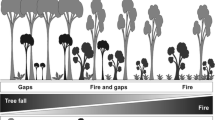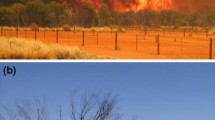Abstract
The season in which a fire occurs may regulate plant seedling recruitment because of: (1) the interaction of season and intensity of fire and the temperature requirements for seed release, germination and growth; (2) post-fire rainfall and temperature patterns affecting germination; (3) the interaction of post-fire germination conditions and competition from surrounding vegetation; and (4) the interaction of post-fire germination conditions and seed predators and/or seedling herbivores. This study examined the effects of different fire intensities and fire seasons on the emergence and survival of shrubs representing a range of fire response syndromes from a summer rainfall cool climate region. Replicated experimental burns were conducted in two seasons (spring and autumn) in 2 consecutive years and fuel loads were increased to examine the effects of fire intensity (low intensity and moderate intensity). Post-fire watering treatments partitioned the effects of seasonal temperature from soil moisture. Higher intensity fires resulted in enhanced seedling emergence for hard-seeded species but rarely influenced survival. Spring fires enhanced seedling emergence across all functional groups. Reduced autumn recruitment was related to seasonal temperature inhibiting germination rather than a lack of soil moisture or competition. In Mediterranean-type climate regions, seedling emergence has been related to post-fire rainfall and exposure of seeds to seed predators. We think a similar model may operate in temperate summer rainfall regions where cold-induced dormancy over winter exposes seeds to predators for a longer time and subsequently results in recruitment failure. Our results support the theory that the effect of fire season is more predictable where there are strong seasonal patterns in climate. In this study seasonal temperature rather than rainfall appears to be more influential.


Similar content being viewed by others
References
Auld TD (1986) Population dynamics of the shrub Acacia suaveolens (Sm.) Willd: fire and the transition to seedlings. Aust J Ecol 11:373–385
Auld TD (1996) Ecology of the Fabaceae in the Sydney region: fire, ants and the soil seedbank. Cunninghamia 4:531–553
Auld TD, Bradstock RA (1996) Soil temperatures after the passage of fire: do they influence the germination of buried seed? Aust J Bot 21:106–109
Beath KJ (2001) GLMStat user manual, version 5.5. Sydney
Bell DT, van der Moezel PG, Delfs JC, Loneragan WA (1987a) Northern sandplain Kwongan: effects of fire on Hakea obliqua and Beaufortia elegans population structure. J R Soc West Aust 69:139–143
Bell DT, Vlahos S, Watson LE (1987b) Stimulation of seed germination of understorey species of the northern Jarrah forest of Western Australia. Aust J Bot 35:593–599
Benson JS, Ashby EM (2000) Vegetation of the Guyra 1: 100 000 map sheet New England Bioregion, New South Wales. Cunninghamia 6:747–872
Bond WJ (1984) Fire survival of Cape Proteaceae—Influence of fire season and seed predators. Vegetatio 56:65–74
Bond WJ, van Wilgen BJF (1996) Fire and plants. Chapman & Hall, London
Bond WJ, Vlock J, Viviers M (1984) Variation in seedling recruitment of cape Proteaceae after fire. J Ecol 72:209–221
Bond WJ, Woodward FI, Midgley GF (2005) The global distribution of ecosystems in a world without fire. New Phytol 165:525–538
Bradstock RA, Bedward M (1992) Simulation of the effects of season of fire on post-fire seedling emergence of two Banksia species based on long-term rainfall records. Aust J Bot 40:75–88
Bradstock RA, Gill AM, Hastings SM, Moore PHR (1994) Survival of serotinous seedbanks during bushfires: comparative studies of Hakea species from southeastern Australia. Aust J Ecol 19:276–282
Bradstock RA, Myerscough PJ (1981) Fire effects on seed release and the emergence and establishment of seedlings in Banksia ericifolia Lf. Aust J Bot 29:521–531
Bradstock RA, Williams JE, Gill MA (2002) Flammable Australia: the fire regimes and biodiversity of a continent. Cambridge University Press, Cambridge
Clark SS (1988) Effects of hazard-reduction burning on populations of understorey plant species on Hawkesbury Sandstone. Aust J Ecol 13: 473–484
Clarke PJ, Davison EA (2001) Experiments on the mechanism of tree and shrub establishment in temperate grassy woodlands: seedling emergence. Aust Ecol 26: 400–412
Clarke PJ, Davison EA, Fulloon L (2000) Germination and dormancy of grassy woodland and forest species: effects of smoke, heat, darkness and cold. Aust J Bot 48:687–700
Clarke PJ, Knox KJE (2002) Post-fire response of shrubs in the tablelands of eastern Australia: do existing models explain habitat differences? Aust J Bot 50:53–62
Cowling RM, Lamont BB (1987) Post-fire recruitment of four co-occurring Banksia species. J Appl Ecol 24:645–658
Enright NJ, Lamont BB (1989) Seed banks, fire season, safe sites and seedling recruitment in five co-occuring Banksia species. J Ecol 77:1111–1122
Grant CD, Loneragan WA (1999) The effects of burning on the understorey composition of 11–13 year-old rehabilitated bauxite mines in Western Australia—vegetation characteristics. Plant Ecol 145:291–305
Grant CD, Loneragan WA, Koch J, Bell DT (1997) Fuel characteristics, vegetation structure and fire behaviour of 11–15 year-old rehabilitated bauxite mines in Western Australia. Aust For 60:147–157
Hanley ME, Fenner M, Ne’eman G (2001) Pregermination heat shock and seedling growth of fire-following Fabaceae from four Mediterranean-climate regions. Acta Oecol Int J Ecol 22:315–320
Hobbs R, Atkins L (1990) Fire-related dynamics of a Banksia woodland in south-western Australia. Aust J Bot 38:97–110
Hodgkinson KC (1991) Shrub recruitment response to intensity and season of fire in semi-arid woodland. J Appl Ecol 115:64–72
Keeley JE, Bond WJ (1997) Convergent seed germination in South African fynbos and Californian chapparal. Ecology 133:153–167
Keeley JE, Zedler PH (1978) Reproduction of chaparral shrubs after fire: a comparison of sprouting and seedling strategies. Am Midl Nat 99:142–161
Knox KJE, Clarke PJ (2004) Fire response syndromes of shrubs in grassy woodlands in the New England Tableland Bioregion. Cunninghamia 8: 348–353
Knox KJE, Clarke PJ (2005) Nutrient availability induces contrasting allocation and starch formation in resprouting and obligate seeding shrubs. Funct Ecol 19: 690–698
Liu H, Menges ES, Quintana-Ascencio PF (2005) Population viability analyses of Chamaecrista keyensis: effects of fire season and frequency. Ecol Appl 15:210–221
Midgley JJ (1989) Season of burn of serotinous fynbos Proteaceae: a critical review and further data. S Afr J Bot 55:65–170
Ooi MKJ, Auld TD, Whelan RJ (2004) Delayed post-fire seedling emergence linked to season: a case study with Leucopogon species (Epacridaceae). Plant Ecol 174:183–196
Pausas JG, Bradstock RA, Keith DA, Keeley JE, GCTE Fire Network (2004) Plant functional traits in relation to fire in crown-fire ecosystems. Ecology 85:1085–1100
Quinn GP, Keough MJ (2002) Experimental design and data analysis for biologists. Cambridge University Press, Cambridge
Setterfield SA (1997) The impact of experimental fire regimes on seed production in two tropical eucalypt species in northern Australia. Aust J Ecol 22:279–287
Spier LP, Snyder JR (1998) Effects of wet and dry seson fires on Jacquemontia curtisii, a south Florida pine forest endemic. Nat Areas J 18:350–357
Vesk PA, Westoby M (2004) Global patterns of sprouting ability; can all plant species be divided into sprouters and non-sprouters? J Ecol 92:310–320
Whelan RJ, York J (1998) Post-fire germination of Hakea sericea and Petrophile sessilis after spring burns. Aust J Bot 46:367–376
Zammit C, Westoby M (1987) Seedling recruitment strategies in obligate-seeding and resprouting Banksia shrubs. Ecology 68:1984–1992
Acknowledgements
We thank the News South Wales National Parks and Wildlife Service (NSW NPWS) for their assistance with this research. Financial support was provided for K. J. E. K. by an Australian Postgraduate Award, an NCW Beadle award and NSW NPWS. The staff and students of Botany at the University of New England helped in various ways. Comments from reviewers and editors were helpful for revision of this article. All experiments comply with Australian law. We thank Wal Whalley for valuable input. We thank Mike Ramsey for advice on GLIMStat.
Author information
Authors and Affiliations
Corresponding author
Additional information
Communicated by Fernando Valladares
Rights and permissions
About this article
Cite this article
Knox, K.J.E., Clarke, P.J. Fire season and intensity affect shrub recruitment in temperate sclerophyllous woodlands. Oecologia 149, 730–739 (2006). https://doi.org/10.1007/s00442-006-0480-6
Received:
Accepted:
Published:
Issue Date:
DOI: https://doi.org/10.1007/s00442-006-0480-6




